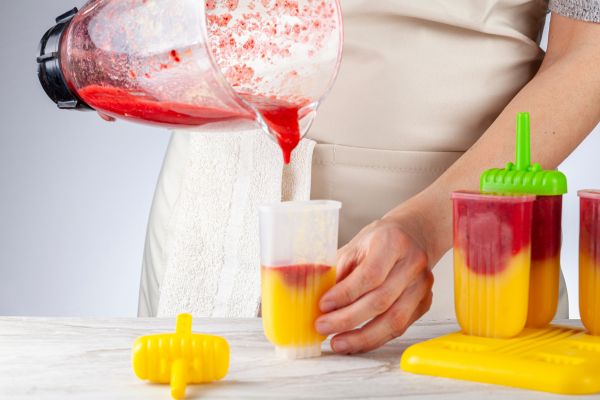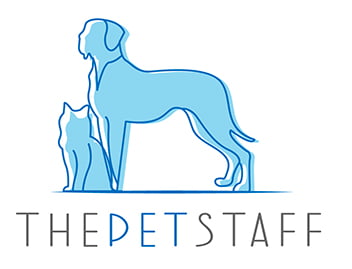During warm weather, it's common for pet owners to want to share their favorite sugary snacks with their dogs. But what about popsicles? Can dogs eat popsicles, or are they better left in the freezer for humans only?
In this guide, we’ll explore whether popsicles are safe for dogs, how to make your own homemade popsicles, and why ingredients like plain yogurt, banana, chicken broth, and blueberries make a healthy alternative for your furry friend.
Can Dogs Eat Popsicles?
Yes, dogs can eat popsicles—but only if they’re the right kind. Dog-friendly popsicles should be made from safe, natural ingredients. Skip the popsicle sticks from the stores, as they often contain toxic components like xylitol, artificial sweeteners, and added sugar, all of which can lead to serious health issues in dogs. Some flavors, such as chocolate or those containing macadamia nuts, are highly toxic.
If you want to treat your dog, choose homemade popsicles made from plain water, dog-safe fruits (such as bananas or blueberries), unsweetened yogurt (if tolerated), or low-sodium broth. It is best to serve it in small portions to prevent any potential discomfort.
Health Benefits of Giving Dog Popsicles

Hydration Support
Dog-friendly popsicles made with water, ice, or low-sodium broth can help keep your dog hydrated, especially in hot weather. Some dogs don’t drink enough water on their own, and licking a cold popsicle can encourage more fluid intake in a fun, refreshing way.
Cooling Relief in Hot Weather
Popsicles provide a great way to cool down overheated dogs. Licking a frozen treat helps regulate body temperature, especially after a walk or outdoor play during summer. This is particularly useful for breeds that are more vulnerable to heat exhaustion, such as bulldogs, pugs, and huskies.
Nutrient Boost
When made with healthy ingredients like yogurt, milk alternatives, and fruits, dog popsicles can provide vital nutrients. Plain yogurt offers probiotics for digestive health, while fruits like blueberries and bananas deliver antioxidants, vitamins, and fiber.
Enrichment and Entertainment
Allowing your dog to chew on or lick a popsicle engages their senses and keeps them mentally stimulated. It also prevents boredom and destructive behavior.
Safe Treat Alternative
When made from dog-safe ingredients like banana, blueberry, pumpkin, or plain yogurt (for dogs who tolerate dairy), popsicles can be a nutrient-rich snack. You can even add supplements like fish oil or turmeric to boost your dog’s intake of omega-3s and antioxidants.
Helps with Teething (for Puppies)
Cold, soft-textured popsicles can offer gentle relief for teething puppies. The cold helps soothe sore gums and reduce inflammation. Just be sure to use appropriate molds and avoid hard chunks that could be a choking hazard.
Downsides of Feeding Popsicles to Dogs
Toxic Ingredients
One of the biggest concerns with giving dogs popsicles is that many store-bought versions contain ingredients that are toxic or unsafe for dogs to consume. Xylitol, a common sugar substitute in many "sugar-free" or low-calorie items, is especially hazardous to dogs. Even in tiny amounts, it can trigger a rapid drop in blood sugar, lead to seizures, cause liver failure, and may be fatal. Other ingredients to watch out for include chocolate, caffeine, and grape juice, all of which are known toxins for dogs. Even artificial flavors, preservatives, and food dyes—though not always lethal—can irritate a dog’s system or trigger allergic reactions. Since dogs’ bodies process chemicals differently than humans, it’s crucial to avoid sharing popsicles unless you are absolutely sure all the ingredients are dog-safe.
High Sugar
Popsicles made for human consumption are often packed with refined sugars or high-fructose corn syrup, which can negatively affect a dog’s health. Dogs have no dietary need for added sugars, unlike humans. Excessive sugar intake can result in weight gain, obesity, insulin resistance, and potentially diabetes over time. In the short term, it may also lead to digestive issues such as stomach upset, gas, or diarrhea. Excessive sugar intake is also detrimental to dental health, as it increases the risk of plaque buildup, cavities, and gum disease. While one sugary popsicle might not cause immediate harm, regularly giving sweet treats can have lasting adverse effects on your dog’s overall health.
Choking Hazard
The texture and composition of some popsicles can present physical hazards to dogs. If the popsicle includes hard-frozen chunks—such as whole fruit pieces—or is served on a wooden or plastic stick, it can pose a choking hazard, especially for small dogs or dogs that tend to chew and swallow quickly without much caution. Additionally, biting into something frozen and hard may result in cracked or chipped teeth, particularly in older dogs or those with existing dental issues. Swallowing pieces of a stick may result in mouth injuries or potentially cause intestinal blockages. Always supervise your dog when serving frozen treats, and avoid giving them anything that contains non-edible parts or large, hard pieces.
Digestive Upset
Dogs not used to certain flavors or ingredients may experience vomiting, gas, or abdominal discomfort. Always wait and observe for any signs of trouble after introducing a new food or treat.
Cold Sensitivity
Dogs, like people, can have sensitive teeth or discomfort from extremely cold foods. While many enjoy licking ice or frozen treats, others may react poorly to the cold temperature of popsicles. Some dogs may experience tooth pain, jaw discomfort, or simply refuse to eat it altogether. Older dogs or dogs with dental disease or exposed nerves are especially at risk for cold-related pain. In rare cases, the shock of a very cold food item could even cause nausea or temporary discomfort in the digestive tract. If your dog shows reluctance or sensitivity, it’s best to offer chilled—not frozen—treats instead.
Homemade Healthy Popsicle Sticks Ideas for Dogs

Instead of purchasing packaged frozen items, try making your own homemade popsicles using natural, dog-safe foods. These quick treats are perfect for hot days, easy to freeze, and free from harmful additives. Here are some pup-approved frozen treats to help your dog stay cool and happy this summer!
Banana & Peanut Butter Pops
Blend banana, xylitol-free peanut butter, and plain yogurt or chicken broth in a blender. Transfer the mixture into ice cube trays or silicone molds, then place them in the freezer until solid. Great for a pup who loves sweet treats!
Frozen Yogurt & Blueberries
Combine plain yogurt with mashed blueberries and a few sliced strawberries. Fill into molds, wait overnight in the freezer, and serve in small amounts to avoid dairy-related issues.
Carrot & Chicken Broth Cubes
Shred fresh carrots and combine with chicken broth. Freeze for a savory, crunchy dog treat your pooch can safely chew on.
Watermelon Ice Cubes
Blend seedless watermelon, then pour into trays. This is a cool, hydrating treat—just like ice cream, but safer!
Strawberry Banana Swirl
Combine sliced strawberries with a banana and a bit of plain yogurt, then blend until smooth. Freeze the mixture into fun shapes using silicone molds. This fruity swirl is rich in fiber, vitamins, and natural sweetness.
Peanut Butter & Crushed Dog Treats
For a texture-rich popsicle, mix xylitol-free, salt-free peanut butter with a splash of water and fold in a few crushed dog treats. Freeze in molds or ice cube trays. This combo offers a savory surprise that most dogs can’t resist.
Ingredients Dogs Should NOT Eat in Store-Bought Popsicles
Xylitol (or Sugar Alcohols)
Xylitol is the most dangerous ingredient to watch out for. It’s a sugar substitute often found in “sugar-free” or low-calorie popsicles. Even small quantities can be hazardous for dogs, potentially causing a rapid decline in blood sugar, seizures, liver damage, or even death. Always check for this ingredient—it may also appear as a “sugar alcohol.”
Artificial Sweeteners (like Aspartame or Saccharin)
Artificial sweeteners such as aspartame, sorbitol, or saccharin are also common in diet-friendly popsicles. While not as deadly as xylitol, they can cause digestive upset and have no nutritional benefit for dogs.
High Fructose Corn Syrup and Excess Sugar
High amounts of sugar or high fructose corn syrup should also be avoided. Excessive sugar intake can result in obesity, diabetes, dental issues, and digestive upset. Dogs have no need for added sugars in their diet, and sweet popsicles provide no nutritional value.
Chocolate or Cocoa
Chocolate or cocoa is extremely toxic to dogs. Chocolate contains theobromine, a compound that dogs have difficulty metabolizing effectively. Ingesting chocolate can cause vomiting, tremors, rapid heart rate, or even heart failure.
Caffeine or Coffee Flavors
Caffeine or coffee flavors are dangerous as well. Caffeine is a stimulant that can impact a dog’s nervous system and heart, possibly leading to restlessness, muscle tremors, or even seizures.
Grapes or Grape Juice
Grapes and grape juice are also highly toxic to dogs, even in small amounts. They can cause sudden kidney failure, and the exact toxic compound is still unknown, so it’s safest to avoid them entirely.
Dairy (for lactose-intolerant dogs)
Dairy ingredients such as milk, cream, or certain types of yogurt can cause digestive issues in lactose-intolerant dogs. Common symptoms include bloating, gas, and diarrhea. If you're unsure whether your dog can handle dairy, it's safer to avoid it altogether.
Artificial Colors or Flavors
Artificial colors and preservatives may irritate a dog’s digestive system or cause allergic reactions. While not always harmful, they provide no benefit and are best avoided, especially for sensitive dogs.
